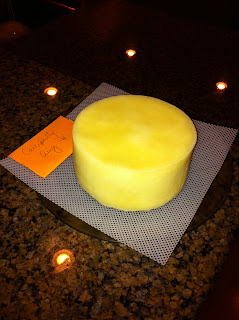| Cornish Pasty |
The Pasty was a food of the Coal miners. A meat and vegetable filled pasty parcel with a thick hard crust on one end was an ideal food to hold in one coal black hand and eat a hearty meal underground. The cheese was often wrapped in cabbage leaves. The same was true for Caerphilly Cheese (pronunciation). Named after the region in Wales this salty cheese with a tough natural rind did not spoil and was a good part of a meal, replacing the salts lost through hard work underground, and like the Pasty, the rind could be discarded once soiled by coal black hands.
So as you sample this full cream, salty cheese, think of the miners peering at their lunch through the light of their helmet candles, with black hands - eager for their cheese and pasty.
 |
| Caerphilly |
The Recipe - makes approx 1 lb wheel
Thanks to fellow Aussie
Cheesmaker Gavin http://www.littlegreencheese.com/2011/07/caerphilly.html
for suggestions
1 gallon full cream milk
1/8 tsp calcium chloride solution in 1/4 cup non chlorinated water
1/8 tsp Mesophilic Starter
- (LL) Lactococcus lactis subsp. lactis
- (LLC) Lactococcus lactis subsp. cremoris
1/8 tsp liquid vegetable rennet ( any rennet will do) in 1/4 cup non chlorinated water
1 table spoon salt
Directions
Heat the milk to 90 F
Add the starter and let rest and develop for 20 minutes
Add Rennet with stirring and 2 minutes and let rest at for 40 minutes or longer until you get a clean curds break
Cut the curds into 1/2 inch pieces
Heat slowly to 92 F with constant stirring and hold for 40 minutes
Drain the curds into a cheese cloth lined colander
Once the curds have drained, cut and "Cheddar" the curds three times in 15 minutes (To "Cheddar" the curds you cut them into 1 inch slabs and stack them up in the along the side of the colander. This helps the syneresis (release of water from the proteins)
Crumble the curds into bits about 1/4 - 1/2 inch
Min in 1 table spoon of seal salt (yes this is a very salty cheese!)
Place the cheese cloth into a mold and press - I use a 5 inch open bottomed mold
Start the press cycle
5 lb for 10 minutes - remove salt the ends, flip and rewrap
5 lb for 10 minutes - remove salt the ends, flip and rewrap
10 lbs for 30 minutes - remove salt the ends, flip and rewrap
20 lbs over night for 12-16 hours
Ageing
Place on a board and draining mat for air flow at room temp (65-75 F) for 2 days till dry to the touch turning a few times a day to allow even drying and fat distribution. The cheese quickly formed the start of a dry rind.
Place in a "cheese cave" - in my case the crisper draw of the fridge at 50 F and >85% humidity for min 3 weeks.
Turn every few days while ageing and if molds develop wipe with a saturated salt solution.
 |
| Curds after 40 minutes at 92 F |
 |
| Drain Curds |
 |
| Cheddar the Curds |
 |
| Crumble and salt |
 |
| Press |
 |
| Remove salt and flip |
 |
| Overnight press in "Patented" Cheese press! |
 |
| Ready for ageing |
UPDATE September 4th
After three weeks in the 55F cave at 85% humidity the cheese has a sold yellow hard rind and I am thinking it is a week away from being cut. Often this cheese is eaten at the three week mark but I think I will develop the flavor a bit more.
Update September 10th
A great cheese - this one will be made again. Perfect for a beer with friends. Good flavor, a salty and creamy taste.
A great cheese - this one will be made again. Perfect for a beer with friends. Good flavor, a salty and creamy taste.
 |
| Caerphilly |

I think that this is the most wonderful explanation of home production of this historic cheese. It would be a pleasure to eat it with you.
ReplyDeleteAusie cheese lover